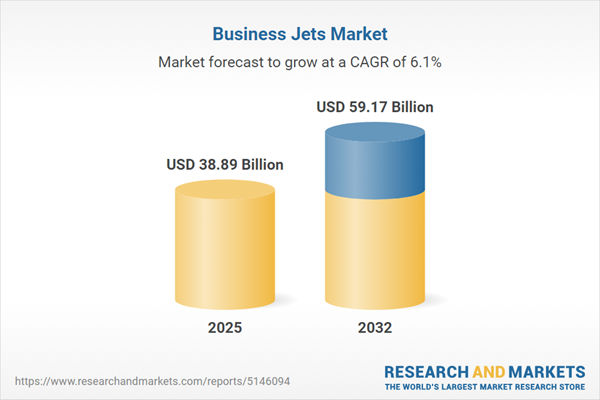Speak directly to the analyst to clarify any post sales queries you may have.
The business jets market is evolving rapidly as executive travel needs transform and new operational models emerge. This report delivers senior leaders a decisive overview of the market’s driving forces, competitive landscape, and growth strategies to enable informed decision-making in a dynamic global environment.
Market Snapshot: Business Jets Market Size and Growth
The business jets market grew from USD 36.71 billion in 2024 to USD 38.89 billion in 2025. With sustained expansion at a CAGR of 6.14%, the sector is expected to reach USD 59.17 billion by 2032. Growth drivers include innovation in cabin design and avionics, evolving regulatory standards, and heightened focus on sustainability. Strategic responses to shifting global trade policies and advancing supply chain models are influencing procurement and operational decisions for manufacturers, operators, and service providers worldwide.
Scope & Segmentation
This report delivers actionable insights across core segments and industries, helping leadership teams align strategies to sector-specific needs and regional trends.
- Aircraft Type: Large, Light, Mid-sized
- Operation Range: Long-Haul Range, Medium-Haul Range, Short-Haul Range
- Propulsion Type: Conventional, Electric, Hybrid systems
- System: Aerostructure, Avionics, Cabin Interiors, Propulsion System
- Applications: Healthcare & Emergency Services, Media & Entertainment, Sports, Travel & Hospitality
- Ownership: New-deliveries, Preowned
- End Users: Charter Operators, Government & State Agencies, Private Owners
- Regions: Americas, Europe, Middle East & Africa, Asia-Pacific
- Key Companies Profiled: Airbus SE, ARC Aerosystems Ltd., Bombardier Inc., Collins Aerospace by RTX Corporation, Dassault Aviation Group, Eclipse Aerospace, Inc., Embraer S.A., Eviation Aircraft Inc., Eviation Alice, Gulfstream Aerospace Corporation, Honda Aircraft Company, LLC, Honeywell International Inc., Joby Aviation, Inc., L3Harris Technologies, Inc., Lilium N.V., NetJets Services, Inc., Pilatus Aircraft Ltd., Piper Aircraft Inc., Rolls-Royce PLC, Textron Inc., The Boeing Company
Key Takeaways for Senior Executives
- The business jets market is being redefined by technological advances in aircraft materials, digital avionics, and data-driven platforms, enabling new operational efficiencies.
- Sustained emphasis on environmental responsibility is accelerating the adoption of alternative propulsion technologies and sustainable aviation fuels.
- The rise of innovative ownership structures, such as membership and fractional programs, is broadening market access and appealing to evolving customer expectations.
- Strategic partnerships between OEMs, service providers, and regional networks are underpinning global supply chain resilience and product innovation.
- Regulatory changes and shifting security requirements are reshaping market entry strategies and necessitating agile compliance frameworks across continents.
- Regional investments in maintenance, repair, and overhaul (MRO) hubs are enhancing service continuity and supporting fleet expansion in emerging high-demand areas.
Tariff Impact: Preparing for US Trade Policy Shifts
The scheduled introduction of United States tariffs in 2025 is prompting stakeholders to rethink procurement and supply chain strategies. Manufacturers are evaluating alternate sourcing to manage cost pressures, while operators are negotiating bundled service agreements to stabilize maintenance and repair costs. Collaborative initiatives between OEMs and component suppliers focus on developing tariff-resilient technologies and strengthening risk management frameworks.
Methodology & Data Sources
Research combines direct interviews with senior executives, technical specialists, and service leadership across OEMs and major supply chain entities. Secondary sources include regulatory filings, technical whitepapers, and recent industry standards. Rigorous data triangulation ensures findings reflect actual market dynamics.
Why This Report Matters
- Enables executive teams to anticipate inflection points, adapt business models, and drive strategic investments aligned with long-term growth opportunities.
- Guides companies in responding to regulatory evolution, sustainability trends, and integration of emerging technologies into product portfolios.
- Provides market intelligence to support risk mitigation, policy compliance, and tailored go-to-market approaches in key regions.
Conclusion
This research empowers stakeholders to navigate the evolving business jets market with clarity and confidence. Leaders equipped with these insights can align strategy, ensure operational resilience, and capture value amid industry transformation.
Additional Product Information:
- Purchase of this report includes 1 year online access with quarterly updates.
- This report can be updated on request. Please contact our Customer Experience team using the Ask a Question widget on our website.
Table of Contents
3. Executive Summary
4. Market Overview
7. Cumulative Impact of Artificial Intelligence 2025
Companies Mentioned
The companies profiled in this Business Jets market report include:- Airbus SE
- ARC Aerosystems Ltd.
- Bombardier Inc.
- Collins Aerospace by RTX Corporation
- Dassault Aviation Group
- Eclipse Aerospace, Inc.
- Embraer S.A.
- Eviation Aircraft Inc.
- Eviation Alice
- Gulfstream Aerospace Corporation
- Honda Aircraft Company, LLC
- Honeywell International Inc.
- Joby Aviation, Inc.
- L3Harris Technologies, Inc.
- Lilium N.V.
- NetJets Services, Inc.
- Pilatus Aircraft Ltd.
- Piper Aircraft Inc.
- Rolls-Royce PLC
- Textron Inc.
- The Boeing Company
Table Information
| Report Attribute | Details |
|---|---|
| No. of Pages | 189 |
| Published | November 2025 |
| Forecast Period | 2025 - 2032 |
| Estimated Market Value ( USD | $ 38.89 Billion |
| Forecasted Market Value ( USD | $ 59.17 Billion |
| Compound Annual Growth Rate | 6.1% |
| Regions Covered | Global |
| No. of Companies Mentioned | 22 |









